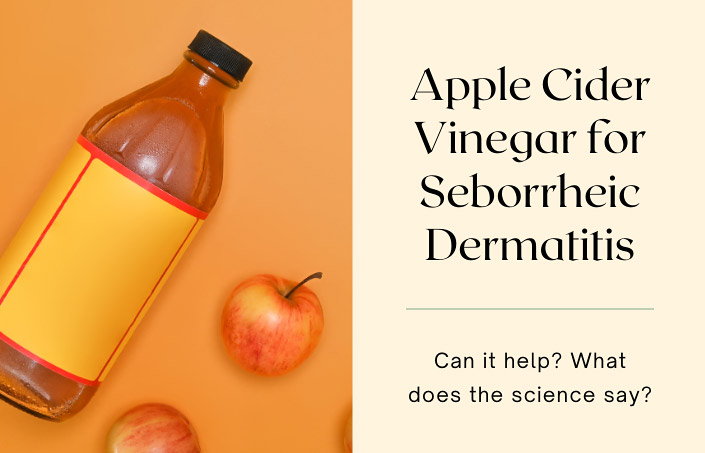
For those looking for natural remedies to combat skin conditions like seborrheic dermatitis, apple cider vinegar (ACV) has become a popular go-to solution. But is it really as effective as some claim it to be? While many proponents praise ACV’s anti-inflammatory, antifungal, and antibacterial properties, its ability to treat seborrheic dermatitis is still a hotly debated topic. Let’s take a closer look at the evidence and decide – is ACV a miracle or just a myth?
Table of Contents
- A brief overview of seborrheic dermatitis
- Conventional treatments for seborrheic dermatitis
- Apple Cider Vinegar and Seborrheic Dermatitis
- Analyzing the Evidence: ACV for Seborrheic Dermatitis
- Alternative Natural Treatments
- ACV-Based Products for Seborrheic Dermatitis
- Precautions and Considerations
- Conclusion
A brief overview of seborrheic dermatitis
Seborrheic dermatitis is a pesky skin condition that can make daily life a bit more irritating. It manifests in the form of red, scaly, and itchy patches, usually in oily areas of the skin like the scalp and face.
While we aren’t quite sure what causes it, we do know that genetics, stress, and too much yeast on the skin could be contributing factors. Even though it’s not dangerous, this condition can be uncomfortable and take a toll on your confidence and daily life.
Conventional treatments for seborrheic dermatitis
Dealing with seborrheic dermatitis can be a frustrating experience, but there are various conventional treatments that can help. Medicated shampoos, antifungal creams, and other prescription medicines can minimize the symptoms associated with this condition. Besides that, finding a skincare routine that works for you, reducing stress, and consuming healthy foods can all provide relief.
Apple Cider Vinegar and Seborrheic Dermatitis
Many people turn to apple cider vinegar as a natural alternative or complement to conventional treatments for seborrheic dermatitis. Some common uses of ACV for this condition include:
- Apple cider vinegar seborrheic dermatitis face treatment: Diluted apple cider vinegar applied with a cotton ball or cloth can help reduce redness and inflammation.
- Apple cider vinegar for seborrheic dermatitis on the scalp: Massaging a mixture of water and apple cider vinegar before rinsing can provide relief from itching and flaking.
- Apple cider vinegar rinse for seborrheic dermatitis: A diluted apple cider vinegar rinse after shampooing can balance your scalp’s pH and reduce the growth of Malassezia yeast.
The science behind apple cider vinegar and its potential benefits
Apple cider vinegar is known for its acetic acid content and is believed to possess several properties that could potentially benefit those with seborrheic dermatitis. These properties include:
- Antifungal properties: ACV has been shown to exhibit antifungal activity against certain fungi, including some strains of Malassezia yeast. This may help control the yeast overgrowth often associated with seborrheic dermatitis.
- Anti-inflammatory properties: The acetic acid in apple cider vinegar is believed to have anti-inflammatory effects, which could potentially help reduce the redness and inflammation associated with seborrheic dermatitis.
- pH balancing effects: Apple cider vinegar is mildly acidic, which may help balance the skin’s pH levels. This could potentially create a less favorable environment for the growth of Malassezia yeast and alleviate seborrheic dermatitis symptoms.
- Natural exfoliation: The acidic nature of apple cider vinegar can help dissolve dead skin cells and promote the shedding of scales associated with seborrheic dermatitis, providing a gentle exfoliation effect.
It is important to note that while these potential benefits may be promising, scientific research specifically addressing the use of apple cider vinegar for seborrheic dermatitis is limited.
More comprehensive studies are needed to confirm the efficacy of apple cider vinegar as a treatment for this skin condition. In the meantime, it is essential to approach the use of apple cider vinegar for seborrheic dermatitis with caution and to consult with a dermatologist or healthcare professional before trying any new treatments.
Analyzing the Evidence: ACV for Seborrheic Dermatitis
Studies and research on apple cider vinegar and seborrheic dermatitis
Although apple cider vinegar has been praised for its antifungal and anti-inflammatory qualities, there is no definitive scientific evidence to confirm its effectiveness in treating seborrheic dermatitis. Most of the claims surrounding ACV as a treatment for seborrheic dermatitis come from personal experiences and anecdotal evidence.
To determine the true effectiveness and safety of using apple cider vinegar for seborrheic dermatitis, more comprehensive and controlled clinical studies are needed.
Drinking apple cider vinegar for seborrheic dermatitis: Does it help?
While some people swear by apple cider vinegar, the truth is that there’s little scientific evidence to support this claim. While drinking apple cider vinegar may offer some health benefits, it’s unlikely to work miracles when it comes to reducing seborrheic dermatitis symptoms. So, while it may be tempting to give it a try, don’t expect this vinegar to be a magic cure!
Expert opinions on using apple cider vinegar to treat seborrheic dermatitis
Navigating the use of apple cider vinegar for seborrheic dermatitis can feel like a maze of conflicting opinions. While some experts suggest it may be a helpful addition to traditional treatments, others are hesitant due to the lack of strong scientific research. To make an informed decision about your own care, it’s crucial to seek the guidance of a healthcare professional who can provide personalized recommendations based on your unique circumstances.
Alternative Natural Treatments
If you are seeking natural alternatives or complementary treatments for seborrheic dermatitis, there are several options to consider. Some popular natural remedies include:
- Tea tree oil: With its antifungal and anti-inflammatory properties, can be added to shampoos or applied directly to affected areas.
- Aloe vera: Aloe vera gel is known for its soothing and moisturizing effects, which can help calm irritated and red skin.
- Honey: Raw honey, when diluted with water and applied to the skin, has been shown to improve symptoms with its antimicrobial and anti-inflammatory benefits.
- Probiotics: With their potential to promote a healthy gut microbiome, consuming probiotics could also help fight off seborrheic dermatitis symptoms.
Comparing apple cider vinegar with other natural remedies
While apple cider vinegar is a popular natural remedy for seborrheic dermatitis, it’s important to weigh its benefits and drawbacks against other alternatives. Here are some factors to consider when comparing treatments:
- Scientific evidence: Assess the available research supporting each remedy’s effectiveness and safety for seborrheic dermatitis.
- Personal experiences: Consider the anecdotal evidence and individual experiences of others who have tried these natural treatments for seborrheic dermatitis.
- Skin sensitivity: Be aware of your skin’s sensitivity to various natural remedies, as some may cause irritation or worsening of symptoms in certain individuals.
- Ease of use: Evaluate the practicality of incorporating each natural treatment into your daily routine.
- Consultation with a professional: Always discuss your options with a dermatologist or healthcare professional before trying any new treatments, whether natural or conventional, for seborrheic dermatitis.
It is important to remember that individual responses to natural treatments may vary, and what works for one person may not work for another. Be patient and open to experimenting with different remedies to find the most effective solution for your unique case of seborrheic dermatitis.
ACV-Based Products for Seborrheic Dermatitis
Apple cider vinegar shampoo for seborrheic dermatitis
Apple cider vinegar shampoos are capturing attention as an intriguing potential solution for seborrheic dermatitis. These enticing shampoos blend ACV with a medley of nature’s most beneficial ingredients, like invigorating tea tree oil, comforting aloe vera, or gentle chamomile, to promote overall hair and scalp health.
These ACV-infused shampoos offer a convenient and accessible way to incorporate the potential advantages of apple cider vinegar into any hair care routine. With balanced pH levels—typically between 4.5 and 5.5—these shampoos help preserve the natural equilibrium of the scalp. Furthermore, they often avoid harsh chemicals, sulfates, and artificial fragrances, making them an appealing choice for those dealing with seborrheic dermatitis.
ACV rinse for seborrheic dermatitis: DIY recipes and ready-to-use products
Apple cider vinegar rinses can be a helpful addition to balance the scalp’s pH levels and potentially reduce Malassezia yeast growth. There are two ways to include ACV rinses in your hair care routine: crafting a homemade mixture or choosing ready-to-use products.
- DIY ACV rinse: To make a simple apple cider vinegar rinse, mix equal parts raw, unfiltered apple cider vinegar and water. After shampooing, apply the diluted ACV solution to your scalp and massage gently. Leave it on for a few minutes before rinsing it with water. It’s crucial to use diluted ACV to avoid irritation, especially for those with sensitive skin.
- Ready-to-use ACV rinse products: If you prefer a pre-made option, there are various apple cider vinegar rinse products on the market. These products often combine ACV with other beneficial ingredients, such as essential oils or herbal extracts, to enhance their potential effects on hair and scalp health. Be sure to read the product labels and follow the manufacturer’s instructions for use.
It’s essential to remember that individual results may vary, and the effectiveness of ACV-based products for seborrheic dermatitis has not been scientifically proven. Consult with a dermatologist or healthcare professional before incorporating apple cider vinegar or any new treatment into your hair care routine.
Precautions and Considerations
Risks and side effects of using apple cider vinegar on seborrheic dermatitis
While apple cider vinegar has potential benefits for those with seborrheic dermatitis, it’s important to be aware of the potential risks and side effects before using it:
- Skin irritation: Undiluted apple cider vinegar can cause skin irritation, burns, or worsen existing seborrheic dermatitis symptoms. Always dilute ACV before applying it to your skin or scalp.
- Allergic reactions: Perform a patch test on a small area of skin before using any new product to check for allergic reactions.
- Dryness: Apple cider vinegar can be drying for some skin types, potentially exacerbating seborrheic dermatitis symptoms. If you experience increased dryness or irritation, discontinue using ACV and consult your dermatologist.
- Interaction with other treatments: Adding apple cider vinegar to your existing treatments, such as topical corticosteroids or antifungal medications, could lead to potential interactions and side effects. Consult your healthcare professional before combining ACV with other treatments.
When to consult a dermatologist or healthcare professional
It is essential to consult a dermatologist or healthcare professional in the following situations:
- Before trying apple cider vinegar or any new treatment for seborrheic dermatitis to discuss potential risks, benefits, and proper usage.
- If your seborrheic dermatitis symptoms worsen or do not improve after trying apple cider vinegar or other treatments.
- If you experience severe skin irritation, allergic reactions, or other side effects after using apple cider vinegar or related products.
- If you have questions or concerns about the most appropriate and effective treatment options for your specific case of seborrheic dermatitis.
A dermatologist or healthcare professional can provide personalized advice and guidance, helping you make informed decisions about the best treatment options for managing your seborrheic dermatitis symptoms.
Conclusion
While the anti-inflammatory and antifungal properties of ACV are well-documented, scientific evidence supporting its effectiveness for seborrheic dermatitis is lacking. Personal experiences and anecdotal evidence are often the basis for claims about the benefits of apple cider vinegar, but more extensive research is needed to truly establish its safety and efficacy as a treatment. If you’re considering trying out ACV as a remedy, be sure to consult with your dermatologist or healthcare professional first.

Petra Nakashian (previously Kravos) is a dedicated natural health and beauty blogger, driven by the loss of her parents to cancer, which led her to meticulously research beauty product ingredients. With over 10 years of experience, her in-depth knowledge has made her a trusted expert in the field. Founder of Be Healthy Now and Green Beauty Talk, Petra recently expanded her expertise with Beauty Insights Hub, exploring a wider range of beauty treatments. Committed to transparency and honesty, her work is a vital resource for navigating the complex world of beauty.

